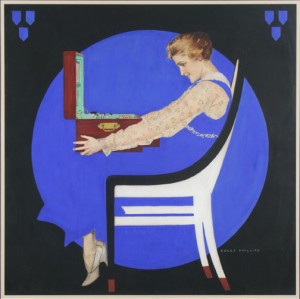
C. Coles Phillips (1880-1927)|New Silver, c.1920|Illustration for advertisement for Oneida Community Silversmiths|Watercolor and gouache on board|The Society of Illustrators, Purchase Fund, accession number 097.007
Oneida Community, Ltd., specialized in producing silver plate and stainless steel flatware marketing “to the woman of modest means who dreamt of having ‘correct service’ with which to decorate her table.”* Instead of selling their product at high end shops, Oneida offered their silver plate at hardware stores, department stores, and through mail-order catalog chains. In 1901, Oneida had an arrangement with the Quaker Oats company so that cereal package coupons could be traded in for Oneida silver plate.
After the turn-of-the-century, Oneida began to emphasize marketing and brand recognition, increasing its promotion budget from $5,000 to $30,000 per year. In 1910, Oneida launched a campaign featuring illustrations by Coles Phillips. Ads in black and white would cost around $2 to $4 to place; a full-color Coles Phillips ad might cost $20 or more.**
During the teens and 20s, Coles Phillips was ranked with most popular illustrators of the day, such as Maxfield Parrish and J.C. Leyendecker. Phillips specialized in images of pretty women, most memorably his ‘Fadeaway Girl’ illustrations. The fadeaway girl image is constructed so that the foreground and background colors are the same, causing the definition of the girl’s body or clothing to be lost in the color. Phillips first created his fadeaway girl illustration for Life magazine in 1908. He used his wife as the model for many of his illustrations.
In this ad the happy model wears a bright blue jumper the same color as the background blue circle. Her sheer cotton blouse has a faded blue-grey leopard pattern print. Her hair style is very similar to the wife’s hair style in Norman Rockwell’s cover for The Literary Digest from May 1920 (see, www.rcavs.org Exploring Illustration entry for October 15, 2009). In this Oneida advertisement, Phillips sat his model in a moderne black and white chair which looks to be a cross between an art deco style in its crisp black and whiteness and the curvilinear sensuousness of chairs by the Judenstil / German art nouveau designer, Richard Riemerschmid (1868-1957). I presume that the brown tips of the chair’s feet are meant to refer to brass fittings.
She admires a wooden chest known as a silverware chest or caddy that she holds on her lap. The chest housed a complete set of silverware or silver plate. Retailers often offered customized silverware chests with the interior constructed to help prevent the flatware from shifting or rubbing against each other. A good quality silverware chest would be airtight so that normal oxidation of the silver exposed to air was slowed, thereby making cleaning easier for the homemaker. This opened chest shows just a bit of the interior arrangement, with the knives tucked into their own storage slots inside the wooden lid. The inner areas of this chest are covered in a turquoise felt or velvet-lined mold that provided slots or wells for the all the pieces of the set.
In the top background of this ad there are a set of blank heraldic devices at either corner. Phillips used similar devices in at least two other illustrations. Since this device is merely decorative and does not reference Oneida Community Silver, it may be seen as a method for balancing the strong color in the painting and finishing the work.
* Randy K. Schwartz, “Oneida Quasquicentennial: Silver for the Middle Class” Repast vol. 22, no. 1 (Winter 2006): 10.
** “Setting the table: Oneida Community Collectibles” by Nancy Gluck AntiqueWeek (January 1996) found at https://www.silverseason.com/OneidaComm.htm
October 1, 2009
By Joyce K. Schiller, Curator, Rockwell Center for American Visual Studies
Norman Rockwell Museum






